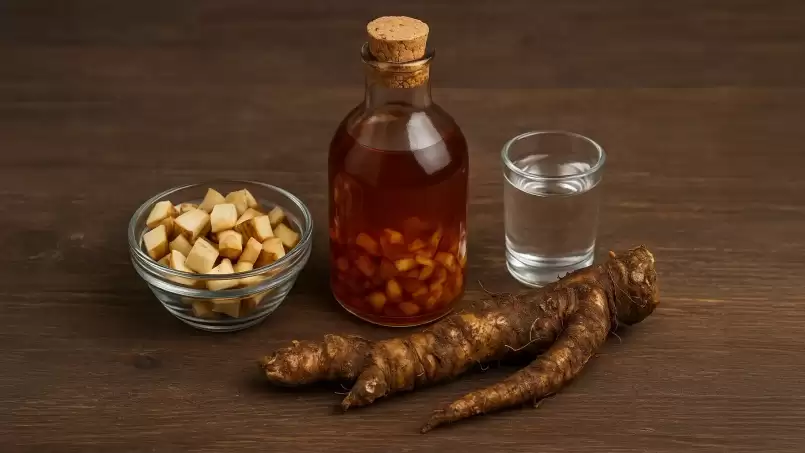Earth butter tincture

Natural Remedy for Rheumatic and Muscle Pain
Discover buttermilk tincture, an effective herbal remedy to relieve rheumatic, muscular and joint pains. Prepared at home, this tincture provides fast and natural relief (rheumatism, muscular pain, osteoporosis, arthrosis, gout).
Servings: 90 servings
This yields ~450 ml of tincture, i.e. ~90 servings of 5 ml each
Ingredients
Materials
- - Glass jar with airtight lid (1 liter)
- - Grater or chopper
- - Dark colored bottle to store the tincture
- - Gauze filter or strainer
Preparation
- Clean and finely chop the earthy buttery root.
- Put the chopped root in the jar up to 60% of its volume.
- Add alcohol until the plant is completely covered and another 2 cm on top.
- Close the jar tightly and macerate for 30 days, shaking daily.
- After maceration, filter the liquid and store the tincture in dark-colored bottles in a cool, dark place.
Use gauze or a sieve press to squeeze out the alcohol absorbed by the root. In this way, some of the plant juice (water and active compounds) is extracted with the alcohol, enriching the tincture. You get a denser, more concentrated but still stable tincture (thanks to the alcohol).
Administration
🔹 Massage the affected area with a small amount of tincture 2-3 times a day.
🔹 For greater effects, a compress of the tincture may be applied to the painful area for 30 minutes, then covered with a warm cloth.
🔹 Duration of treatment varies depending on the severity of the condition, but continuous use for longer than 4 weeks without medical advice is not recommended.
⚠️ Test the tincture on a small area of skin before extended use.
⚠️ Wash hands after application.
⚠️ Avoid contact with eyes and mucous membranes.
⚠️ Do not take internally!
Observations
Recommended for:
- Rheumatologic disorders: rheumatism, arthrosis, spondylosis, gonarthrosis, coxarthrosis, gout, osteoporosis, rheumatoid arthritis, tendonitis, bursitis, myalgia, myalgia, periarthritis, lumbago, sciatica, lumbago.
- Muscle and soft tissue disorders: muscle aches, sprains, strains, sprains, muscle contractures, soft tissue inflammation
- Dermatologic conditions: dermatitis, psoriasis, warts and moles, impetigo, foot fungus.
- Circulatory disorders: varicose veins, atherosclerosis.
- Neurological disorders: migraine, insomnia.
Effects and benefits
- Relieves rheumatic pain
- Reduces joint inflammation
- Soothes muscle aches
- Improves joint mobility
- Stimulates local blood circulation
- Accelerates healing of contusions and bruises
- Reduces edema and swelling
- Relieves gout symptoms
- Helps treat osteoporosis
- Effective in cervical spondylosis
- Soothes meniscus pain
- Useful in treating sinusitis
- Relieves symptoms of sh shingles
- Reduces low back pain
- Helps to treat bone deformities (lumps, knurs)
- Effective in arthritis and arthrosis
- Soothes cramps and muscle spasms
- Helps heal frostbite
- Useful in treating acne and dermatoses
- Relieves symptoms of bronchitis and pneumonia
Side effects
- Local irritation or burning
- Allergic skin reactions
- Burning or itching sensation
- Excessive redness of the skin
- In rare cases, blistering
Contraindications
- Earth butter allergy
- Sensitive skin or open sores
- Pregnancy and breastfeeding
- Children under 12 years
- People with severe dermatologic conditions
FAQ 💡❓
Why is the herb considered toxic internally but so valuable externally?
➡️ Because irritants that would cause severe inflammation internally become useful externally, stimulating circulation and reducing pain.
Is the tincture more effective if the radish is freshly picked during certain months of the year?
➡️ Yes, late fall and early spring the root contains maximum concentrations of active compounds, especially saponins and mucilages.
How does the alcohol concentration influence the final extract?
➡️ 40% alcohol extracts water-soluble and alcohol-soluble principles excellently, but if you want more irritating action (for mounts, stumps), 70% alcohol is more penetrating.
Does the tincture change color or smell if too old?
➡️ Yes, it becomes darker in colour and takes on a more intense smell - a sign that oxidation is beginning. It is no longer effective after 2 years.
Can the tincture be combined with massage therapy for greater effect?
➡️ Absolutely! When applied before the massage, it activates local circulation and opens the pores, enhancing the massage effect.
What effect does the tincture have on peripheral nerves affected by diabetes?
➡️ It can slightly stimulate circulation in areas affected by neuropathy, but should be tested carefully on fragile skin.
Is there a difference in effectiveness between home-made tincture and commercially available tinctures?
➡️ Yes, freshly prepared at home from unprocessed root may be stronger and richer in volatile compounds.
Why do some recommend using as a compress rather than just rubbing it in?
➡️ The compress keeps the tincture in contact with the skin for longer, increasing absorption and in-depth therapeutic effectiveness.
Can it affect skin flora or cause dryness with repeated applications?
➡️ Yes, excessive application can unbalance the natural lipid layer. Breaks and alternative moisturizing are recommended.
What does it mean when the area becomes slightly red and warm after application?
➡️ This is a normal reaction - the tincture stimulates microcirculation. If the sensation persists or becomes stinging, stop use.
Is there any connection between the effects of the tincture and those of chili pepper?
➡️ Interestingly, yes - both act through mild local irritation, triggering a reflex anti-inflammatory and analgesic reaction.
Can the tincture be applied to acupuncture points for deeper effects?
➡️ Yes, alternative practitioners sometimes use it on reflex points for localized stimulation.
Can the tincture help with pain caused by cold or damp weather?
➡️ Yes, as it stimulates circulation and reduces the sensitivity of joints to climatic changes.
Can it be an ally in recovery after fractures or sprains?
➡️ In the recovery phase (after acute inflammation is over), yes - it supports vascularization and local regeneration.
How can I customize the recipe for a gentler tincture for sensitive skin?
➡️ You can dilute the final tincture with vegetable glycerin or apply over a thin layer of vegetable oil for protection.
Comments